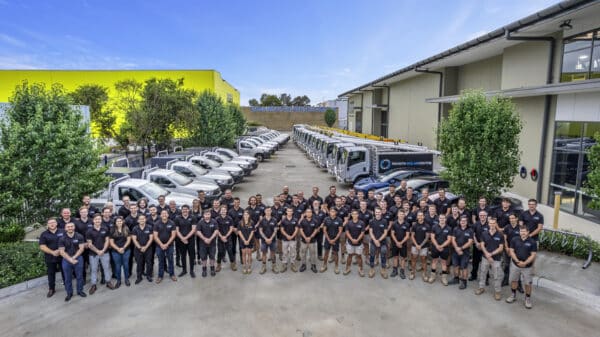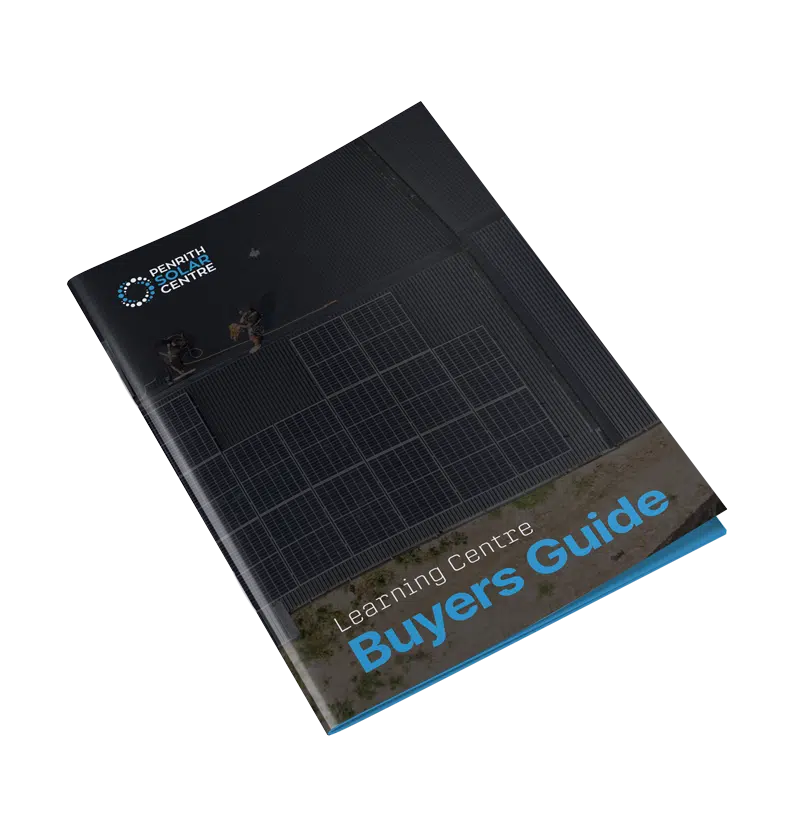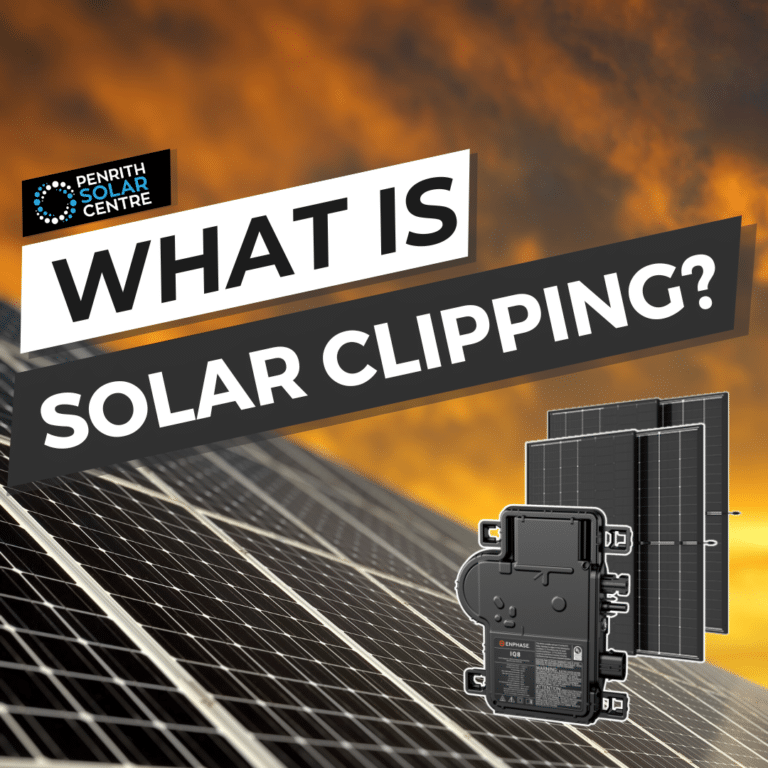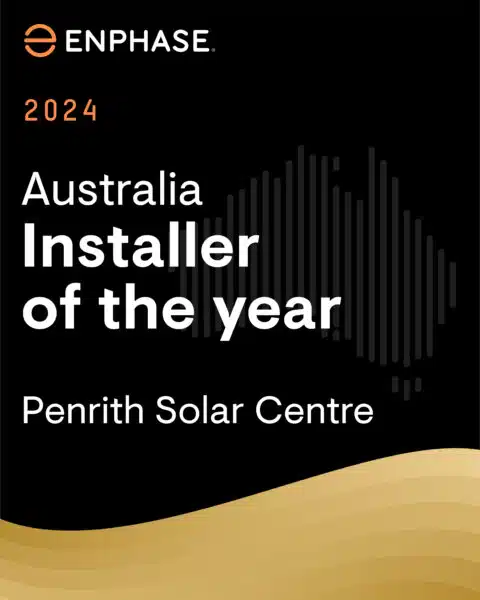
If you’re considering adding a solar battery to your solar system, you’ve probably already heard about Tesla’s Powerwall 3. They’ve launched a new battery and we’re here to tell you about it.
Tesla has made a name for itself by pushing the boundaries of technology, and its latest release, the Powerwall 3, is no exception. But does it live up to the hype?
At Penrith Solar Centre, we understand how complicated solar shopping can be. There’s a steep learning curve when it comes to the specifications of solar batteries. Don’t worry, we’re here to guide you through that decision-making process for the Powerwall 3.
In this article, you will learn:
- What is the Powerwall 3?
- What Are the Specs and Features of Tesla Powerwall 3?
- Powerwall 2 vs. Powerwall 3
- Who is Powerwall 3 a Good Fit For?
- Who is Powerwall 3 a Bad Fit For?
- Should You Buy the Tesla Powerwall 3?
By the end of this article, you will be able to figure out if Powerwall 3 is the right fit for your home.

What is the Powerwall 3?
The Tesla Powerwall 3 is a home battery system designed to store energy from your solar panels or the grid. You can then use that energy to power your home when the sun isn’t shining or during power outages. The Powerwall 3 can hold 13.5 kilowatt-hours (kWh) of energy, just like its predecessor, the Powerwall 2, but it comes with some changes.
What Are the Specs and Features of Tesla Powerwall 3?
Specifications
- Capacity: The unit offers a storage capacity of 13.5 kWh.
- Scalability: Expandable up to four units for a capacity of 54kWh for now, but in the first quarter of 2025 it will be expandable up to 216kWh.
- Power Output: 11.04 kW continuous power output. Unfortunately, in most cases, it must be programmed for a maximum output of 10kW due to DNSP grid limits for inverters in New South Wales.
- Charge Power Rating: 5kW of power input to charge the battery.
- Operating Temperature: -20°C to 50°, indoor and outdoor rated.
- Dimensions: 1099 mm x 609 mm x 193 mm.
- Weight: 130kg
- Mounting: Floor or wall mounting.
Integrated Inverter: One of the biggest changes in the Powerwall 3 is the built-in solar inverter. This feature means that string inverter solar systems no longer need a separate hybrid inverter. Powerwall 3’s inverter can convert the energy solar panels produce into electricity that your home can use. If you’re shopping for a string inverter system with a battery, this combination when paired with solar will save you money.
Safety: Tesla has opted for lithium iron phosphate (LFP) cells for the Powerwall 3. These cells are known for their stability and safety, offering a lower risk of thermal runaway compared to nickel manganese cobalt (NMC) cells used in Powerwall 2.
Flood-resistant Design: Tesla has designed the Powerwall 3 to withstand tough conditions. It can be submerged in water up to 600 millimetres, making it more resilient in areas prone to extreme weather with the possibility of mild flooding.
Solar Input: Because the Powerwall 3 is an inverter/battery combo, there are limits to the number of panels it can support and how it interacts with them. The Powerwall 3 supports up to 20kW of solar.
Multiple Trackers: The Powerwall 3 includes three Maximum Power Point Trackers (MPPTs). When panels experience things like shading or different orientations, the MPPTs adjust and optimise the power output to match the best possible performance.

Design and Build Quality
The Tesla Powerwall 3 has a sleek, modern look. The unit is slimmer and taller than the Powerwall 2 but deeper, measuring 1105mm tall, 609mm wide, and 193mm deep. This gives customers a little more wall space which is great for a second battery.
The tempered glass front gives it a polished finish, but it also raises concerns about durability. Although Tesla assures that the glass is tough, the possibility of breakage remains, especially in areas prone to harsh weather conditions like hail or projectiles like an errant cricket ball.
The Powerwall 3 can be mounted on the wall or the floor/ground, offering flexibility depending on your space. However, at 130 kilograms, it’s quite heavy so installing it on the ground might be the best option.
One notable feature is the redesigned mounting bracket. When you combine the mounting bracket with the leveling feet, you’ll get a perfect finish. This is especially useful on uneven surfaces.

Performance:
Higher Power Output: The Powerwall 3 can deliver up to 11.04kW of continuous power, which is more than the Powerwall 2. However, your local energy distributor (Ausgrid, Endeavour Energy, or Essential Energy if you’re in New South Wales) will have a kilowatt limit for your home inverter. It’s 10kW for single-phase in Ausgrid, Endeavour Energy, and the Essential Energy networks. So, the 11.04kW will be programmed to a sweetly reasonable 10kW of output, respectfully.
DC-Coupled Design: We mentioned the inverter in the Powerwall 3. Essentially, it’s a hybrid inverter inside a solar battery. There’s a bypass around the inverter that directly feeds the cells with power from the solar while the hybrid inverter handles discharging or charging power for the home or grid.
The Powerwall 3’s DC-coupled design reduces energy conversion losses. When a battery is charging and discharging, an amount (usually a small amount) of power is lost. That effort causes losses in efficiency.
- Powerwall 2 (AC-coupled): 92 – 93% charging efficiency.
- Powerwall 3 (DC-coupled): 96 – 97% charging efficiency.
The Powerwall 3 can be used as an AC-coupled option for adding it to a system with microinverters, but the efficiencies for charging and discharging will be slightly less as you can see in the above figures.
Protection in Blackouts: The Powerwall 3 provides reliable backup during power outages. Tesla’s Backup Gateway 2 (a compulsory piece of equipment) manages the seamless transition between grid power and stored energy. The power supply remains uninterrupted.
Safety:
The Powerwall 3’s design also emphasises Tesla’s commitment to safety. The unit includes arc fault protection, which helps prevent electrical fires by detecting and shutting down dangerous arcs in the system.
However, it has limitations in how it’s able to detect arcs. It can detect arcs on one leg of the DC (negative or the positive) but if the DC has a hard short on it, then the arc fault detection will be useless.
This is part of the risk of DC architecture in your solar system. It’s more efficient, but there’s still high-voltage electricity running down the side of your home. It is slightly more efficient but comes with the inherent risks of DC.
Of course, the best investment you can make if you’re worried about safety is hiring a quality installer. A good installation will make sure your Powerwall is installed in a place where it will be resistant to the elements and the wiring will be safely threaded through the home.
Noise Considerations: Another installation challenge is the noise level. Unlike the Powerwall 2, the Powerwall 3 is not liquid cooled. The Powerwall 3 has built-in fans to cool the system, and these fans can produce noticeable noise. In a quiet home, this might be annoying, so it’s something to consider when choosing the location for your Powerwall 3.
If you’re interested in learning a bit more about the importance of a good installer for your solar (the most important component of any system, seriously), you might want to check out the following article titled, In-house Installers vs. Subcontractors: Which is Better?
Futureproofing and Scalability
Expansion Possibilities: Tesla is always thinking ahead, and the Powerwall 3 is no exception. One of the most exciting features is its scalability.
In the first quarter of 2025, Tesla plans to release a “dumb” version of the Powerwall 3 that doesn’t have an inverter in it. It will be an expansion unit that can double the energy storage capacity without adding another inverter.
This means you can start with one Powerwall 3 and easily upgrade by adding a “dumb” version of the battery as your energy needs grow. Tesla has announced that you will be able to stack up to 16 “dumb” units for a total of 216kWh.
Installation and Future Upgrades: Tesla has made sure that future upgrades are as simple as possible for installers. The “dumb” expansion units will be plug-and-play, meaning you won’t need to overhaul your existing setup to increase your energy storage. It can be done efficiently and safely.
Pricing and Value
The Tesla Powerwall 3 is priced at $13,600 for the battery and the Backup Gateway 2. This price point is higher than many other battery systems on the market, but it’s essential to consider the value it offers.
These numbers don’t cover the cost of installation. That varies significantly from installer to installer, regardless of the battery, as you’ve probably noticed with the quotes for solar you’ve received.
When you bundle Powerwall 3 with solar, it presents a compelling case for those looking to invest in long-term energy independence with a string inverter solar system.
Tesla’s pricing strategy also includes incentives for recycling the packaging of the Powerwall 3. The packaging is fully recyclable, and Tesla offers a credit for returning it. While this initiative is environmentally friendly, the packaging’s appearance has drawn some criticism for being unattractive.
Powerwall 2 vs. Powerwall 3
The Powerwall 3 offers some upgrades compared to the Powerwall 2. Let’s briefly compare the two batteries.
Higher Power Output: This is a huge upgrade. The continuous power output rating of 11.04kW is a lot, even though the output needs to be capped at 10kW. The Powerwall 2 has a continuous power rating of 5kW. It’s a significant upgrade.
Lithium-ion Phosphate: This is a great upgrade, which we mentioned above. Lithium-ion Phosphate is safer and ethically mined and manufactured.

If you’re interested in learning a bit more about the upcoming solar battery rebate, you might want to check out the following article titled, Everything You Need to Know About the Home Battery Rebate for NSW.
Who is Powerwall 3 a Good Fit For?
Single-phase Homes:
- It’s a single-phase battery designed for single-phase homes. If you’re installing solar on a three-phase site, Powerwall 3 is a complicated option for technical reasons.
New Installations for Solar + Battery:
- It’s a great option to have installed with solar panels because of its inverter. Pairing it with panels and bundling it all together saves money.
People Who Have and Love Tesla Products:
- Tesla manufactures great products. The brand has ferocious loyalty for a reason and integrating solar and battery with a Tesla EV and charger will set customers up for an electric lifestyle. This is an eventuality in Australia, and Tesla is leading the charge.
If You Don’t Want Microinverters:
- The Powerwall 3 is a string inverter solar system. It’s a great fit for anyone who wants strings, but there will be inherent risks that go along with installing a string inverter solar system. Rather than rehash them here, we recommend you check out the following article titled, Microinverters vs. String Inverters: A Transparent Comparison.
Blackout Protection:
- If you live in an area prone to a lot of blackouts, this battery can output up to 10kW (11.04kW) of continuous power.

Who is Powerwall 3 a Bad Fit For?
Retrofit Compatibility:
- If you have a microinverter system and you’re keen to add on a solar battery, you may want to shop outside of this brand. There are more economical options designed to work with microinverter solar systems. It’s an expensive option if you want it added to an existing solar system.
Three-phase Compatibility:
- We mentioned this briefly above. The phases on a three-phase site need to be balanced, which will be a challenge with Powerwall 3. It’s a technical issue that you can learn more about if you check out the following article titled, Can I Install a Single-Phase Battery on a Three-Phase Home?
Decentralised Solar Systems:
- It’s not the best option if you’re keen to avoid central points of failure in the architecture of your solar system. Remember, the Powerwall 3 has one inverter in it, and if that inverter fails, the whole system goes down.
Safety Conscious:
- Solar systems with high-voltage DC architecture are inherently risky by design. The electricity coming down the side of the house to the Powerwall 3 is much higher voltage than an AC system with microinverters. While Powerwall 3 is perfectly safe if it’s installed correctly, however, that doesn’t always happen. Choose your installer carefully.
Noise Levels:
- As mentioned earlier, the cooling fans in the Powerwall 3 can be noisy. If you’re sensitive to noise or plan to install the Powerwall 3 in a quiet area of your home, this could be a concern.
Backwards Compatibility:
- The Powerwall 3 is not backward compatible with the Powerwall 2. This means if you already own a Powerwall 2 and want to add more storage, you’ll need to order another Powerwall 2 soon. The Powerwall 2 is being phased out and replaced with Powerwall 3.
If you’re interested in learning a bit more about the rapid shutdown feature in a solar system, you might want to check out the following article titled, How Important is Rapid Shutdown in a High Voltage DC Solar System?

Should You Buy the Tesla Powerwall 3?
The decision to purchase a Tesla Powerwall 3 depends on several factors, including your energy needs, existing solar setup, and budget. If you’re looking for a high-performance, scalable energy storage solution and are willing to invest in a premium product, the Powerwall 3 is an excellent choice. Its ability to integrate directly with solar panels and handle large power loads makes it an economical option.
If you’re looking for a reliable, high-capacity battery that can handle your home’s energy needs now and, in the future, the Powerwall 3 is worth considering. Just be sure to weigh the pros and cons carefully and consult with a professional installer to ensure it’s the right choice for your home.
At Penrith Solar Centre, we’re committed to helping you find the exact system for your needs. Every system is customised with safety and efficiency in mind. We start with a conversation to assess your unique needs and goals. We listen to you and design your system appropriately, safely, and with exceptional customer care.

If you’re interested in learning a bit more about the upcoming solar battery rebate, you might want to check out the following article titled, Everything You Need to Know About the Home Battery Rebate for NSW.










